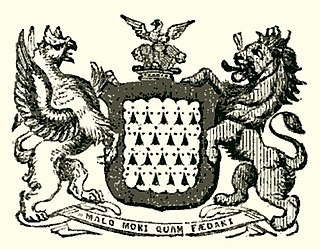Related Research Articles

The title Baron of Dunsany or, more commonly, Lord Dunsany, is one of the oldest dignities in the Peerage of Ireland, one of just a handful of 13th- to 15th-century titles still extant, having had 21 holders, of the Plunkett name, to date. Other surviving medieval baronies include Kerry, Kingsale, Trimlestown (1469), Baron Louth, and Dunboyne.
Alexander Plunket was an Irish statesman and judge of the fifteenth century.

Rowland FitzEustace, 1st Baron Portlester was an Irish peer, statesman and judge. He was one of the dominant political figures in late fifteenth-century Ireland, rivalled in influence probably only by his son-in-law Garret FitzGerald, the "Great" Earl of Kildare.
Plunkett is an Irish surname derived from the Gaelic Ó Pluingceid. It is associated with Ireland, and possibly of Norse or Norman origin; it may be spelled O'Plunket, Plunket, Plunkit, Plunkitt, Plonkit, Plonkitt, Plonket, Plonkett, or Ó Plunceid, and may refer to:
Earl of Fingall and Baron of Killeen were titles in the Peerage of Ireland, the latter one of the earliest surviving, while Baron Fingall was a title in the Peerage of the United Kingdom. The seat of the title-holders was, from the 1400s until 1953, Killeen Castle in County Meath, Ireland, and there was an ongoing close relationship with the related Plunkett family of Dunsany, and with the Viscounts Gormanston, with whom they intermarried.
Christopher Plunkett, 1st Baron of Dunsany was an Anglo-Norman peer. He was the second son of Sir Christopher Plunkett and Genet de Cusack.
Thomas Eustace, 1st Viscount Baltinglass was an Anglo-Irish noble who achieved wealth and influence by prudently remaining loyal to the English Crown. He was born circa 1480 at Caslemartin, County Kildare.
Christopher Fleming was an Irish nobleman, who was Lord High Treasurer of Ireland from 1514 until his death. He succeeded as 8th Baron Slane in 1492.

Margaret Butler, Countess of Ormond, Countess of Ossory was an Irish noblewoman and a member of the powerful and celebrated FitzGerald dynasty also known as "The Geraldines". She married Piers Butler, 8th Earl of Ormond, by whom she had three sons and six daughters.

John Barnewall, 3rd Baron Trimleston, was an Irish nobleman, judge and politician. He was the eldest son of Christopher Barnewall, 2nd Baron Trimlestown and his wife Elizabeth Plunket, daughter of Sir Thomas Fitz-Christopher Plunket of Rathmore, Lord Chief Justice of the King's Bench in Ireland and his second wife Marian Cruise. He succeeded his father as 3rd Baron in about 1513. His father, like most of the Anglo-Irish aristocracy, had supported the claim of the pretender Lambert Simnel to the English throne in 1487. After the failure of Simnel's rebellion, he received a royal pardon.
Robert Preston, 1st Viscount Gormanston (1435–1503) was an Irish peer and statesman of the fifteenth century who held the offices of Deputy to the Lord Chancellor of Ireland and Lord Deputy of Ireland.
Sir Robert FitzEustace (c.1420–1486) was an Irish landowner and politician of the fifteenth century.
Robert Plunkett, 5th Baron Dunsany was an Anglo-Irish nobleman of the Tudor period.
Edward Plunkett, 4th Baron of Dunsany was an Irish nobleman; he was killed in battle during the Irish Rebellion of 1520–1.
Richard Nugent, 2nd Earl of Westmeath was an Irish nobleman.

Gerald FitzGerald, 8th Earl of Kildare, known variously as "Garret the Great" or "The Great Earl", was Ireland's premier peer. He served as Lord Deputy of Ireland from 1477 to 1494, and from 1496 onward. His power was so great that he was called "the uncrowned King of Ireland".
Sir William FitzWilliam, of Windsor, Berkshire, was an Irish courtier and Member of Parliament in England. He was Chief Gentleman of the Privy Chamber to Edward VI of England; Deputy Chancellor of Ireland; Lieutenant of Windsor Castle; Keeper of Windsor Great Park and Lord Lieutenant of Berkshire.

John Plunkett, 3rd Baron of Dunsany was an Irish nobleman.
Christopher Plunkett, 6th Baron of Dunsany was an Irish nobleman.
Patrick Plunkett, 7th Baron of Dunsany was an Irish nobleman.
References
Footnotes
- ↑ Morris, Susan, ed. (2020). Debrett's Peerage and Baronetage 2019. eBook Partnership. p. 2460. ISBN 9781999767051.
(1) Sir Christopher Plunkett, 2nd son of 1st Baron Killeen ... cr Baron of Dunsany by writ 1439, and by patent 1461; s by his son, (2) Richard, 2nd Baron; s by his son (3) John...
- 1 2 3 4 Carty, Mary-Rose; Lynch, Malachy (2000). The Story of Dunsany Castle. Dunsany, County Meath, Ireland. pp. 21–24. ISBN 0951738216.
{{cite book}}: CS1 maint: location missing publisher (link)